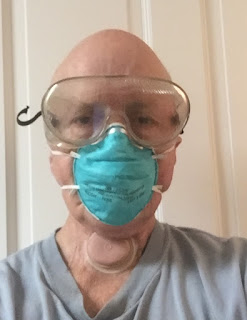Laringectomía y Total y el nuevo virus
corona: Sugerencias para la protección.
30 de marzo de 2020. Dr. Itzhak Brook.
Sugerencias sobre cómo los pacientes con
cáncer de cabeza y cuello (incluidos los que respiran el cuello) pueden
protegerse de la nueva infección por coronavirus (COVID -19).
Los pacientes con cáncer de cabeza y
cuello (CCC) y los respiradores de cuello (incluidos las laringectomías) pueden
tener un mayor riesgo de sufrir una infección grave por COVID-19. El riesgo de
enfermedad grave es especialmente alto en aquellos que actualmente reciben o
han recibido recientemente quimioterapia o terapia inmunosupresora.
Es prudente que los pacientes con CCC y
los respiradores de cuello sigan las instrucciones del gobierno y las
autoridades de salud locales y eviten la exposición al virus siguiendo las
indicaciones de aislamiento estrictamente.
Los respiradores de cuello son
susceptibles a las infecciones del tracto respiratorio inferior porque el virus
puede ingresar a su tracto respiratorio directamente a través del estoma del
cuello. Los virus respiratorios también pueden acceder al cuerpo a través de la
boca, la nariz y la conjuntiva. Por lo tanto, es imperativo que tales
individuos ejerzan un cuidado especial para evitar infectarse.
COVID-19 puede causar una infección grave
en personas con vías respiratorias comprometidas. Las vías respiratorias de los
laringectomas pueden verse comprometidas porque su tráquea y bronquios a menudo
están secos e irritados crónicamente, y su capacidad pulmonar puede verse
reducida debido al colapso parcial de sus lóbulos inferiores (atelectasia).
Las medidas que pueden reducir el riesgo
de infección incluyen:
Limpieza frecuente de manos:
• Lavarse las manos con frecuencia con
jabón y agua caliente durante al menos 20 segundos, especialmente después de
estar en un lugar público, o después de limpiarse el estoma del cuello, sonarse
la nariz, toser o estornudar.
• Si no hay agua y jabón disponibles, use
un desinfectante para manos que contenga al menos 60% de alcohol.
• Evitar tocarse los ojos, la nariz, la
boca y el estoma con las manos sin lavar.
Evitar el contacto cercano:
• Evitar el contacto cercano con personas
enfermas.
• Poner distancia entre uno mismo y otras
personas. Esto es especialmente importante para las personas que corren un
mayor riesgo de enfermarse gravemente.
Tomar medidas para proteger a los demás:
• Quedarse en casa cuando está enfermo,
excepto para recibir atención médica.
• Cubrirse cuando tosa y estornude
• Cubrirse la boca, la nariz o el estoma
con un pañuelo al toser o estornudar o al usar el interior del codo.
• Tirar pañuelos usados a la basura.
• Lavarse las manos inmediatamente (ver
arriba)
• Usar una mascarilla cuando está enfermo
Limpieza y desinfección:
• Limpieza y desinfección de superficies
frecuentemente tocadas.
• Evite tocar superficies que no estén
limpias.
• Lávese las manos inmediatamente después
de tocar una superficie que no estaba limpia.
Los laringectomizados pueden protegerse
tomando estos pasos adicionales:
• Usar un intercambiador de calor y
humedad (HME) 24/7 si pueden. Un HME proporciona humidificación del aire inhalado
y cierto nivel de filtración (mecánica) dependiendo del tamaño de la partícula
en relación con el tamaño de poro del material HME y la tapa sólida evita el
contacto directo entre el dedo y el estoma (es decir, Provox XtraMoist y Provox
XtraFlow de Atos Medical).
Las HME con alta eficiencia de filtración
funcionarían mejor para reducir el riesgo de inhalar el virus (es decir, Provox
Micron de Atos Medical). Provox Micron es un HME que tiene un filtro
electrostático integrado que proporciona una eficiencia de filtración de>
99% para bacterias y virus y su cubierta evita el contacto directo de los dedos
con el estoma. El filtro electrostático proporciona filtración
independientemente de la dirección del flujo de aire, por lo que usarlo también
protege a otras personas de infectarse cuando el laringectoma está infectado.
(ver foto 1)
• Usar un HME de manos libres, que no
requiere tocarse al hablar, en quienes usan el habla traqueoesofágica con una
prótesis de voz. Aquellos que usan un HME regular deben lavarse las manos antes
de tocar su HME.
• Usar una mascarilla (preferiblemente
N95) sobre el estoma (ver fotos 2-4). Se puede modificar una máscara facial con
cuatro cuerdas para que se ajuste sobre el estoma. Una de las cadenas se puede
extender con una cadena adicional; y el par inferior de cuerdas se puede atar
detrás de la espalda.
• Usar mascarilla sobre la nariz y la
boca, y anteojos protectores. Esto puede evitar que el virus ingrese al cuerpo
a través de estos sitios.
Si se usa correctamente, una máscara
facial puede ayudar a bloquear las gotas de partículas grandes, salpicaduras,
aerosoles o salpicaduras que pueden contener gérmenes (virus y bacterias). Las
mascarillas también pueden ayudar a reducir la exposición de las secreciones
respiratorias del usuario a otras personas.
Los pacientes con CCC (incluidos los
laringectomas) deben consultar a sus médicos acerca de los pasos adicionales a
seguir.
Para protegerse. Las personas deben
comunicarse con sus médicos ante cualquier signo de infección respiratoria.
Finalmente, aunque todas estas medidas
pueden ser útiles para proteger a los pacientes con CCC y los respiradores de
cuello Infección por COVID-19, no son necesariamente infalibles y ciertamente
no se garantiza que eviten la adquisición una infección.
Itzhak Brook MD
Departamento de Enfermedades Infecciosas
Profesor de Pediatría y Medicina.
Facultad de medicina de la Universidad de
Georgetown
Washington DC
Estados Unidos
Suggestions in Spanish: Laringectomía y Total y el nuevo virus corona: Sugerencias para la protección.
Foto 1
Foto 2
Foto 3
Foto 4















